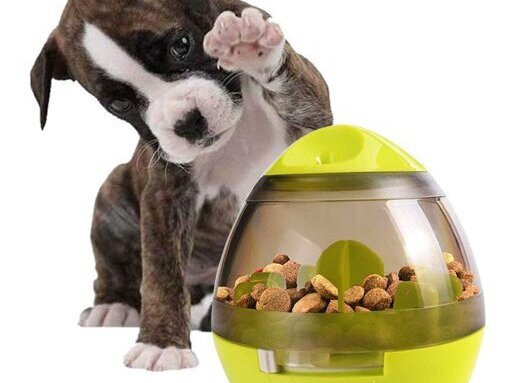Ditching the Bowl: How Puzzle Feeding Benefits Your Pets
Puzzle feeders can slow down eating while providing stimulation and entertainment
For most animals, food can be a powerful motivator, and our canine companions are no different. The way food is presented and the effort required to obtain it can influence both negative and positive behaviors.
In fact, when offered a choice between free feeding and food that requires effort, many animals prefer to work for the food, a concept known in the zoo world as “contra freeloading.” You may have noticed zoo animals working for food with various types of enrichment feeders, puzzles, or climbing apparatus. Similar methods can be applied right in your own home for your pets.
Let’s take a look at some of the benefits of puzzle feeding.
Reduction of Negative Behaviors
Dogs are more intelligent than we think (some have even learned over 1,000 words) and most like to use their brains. Feeding from a bowl requires no mental energy, leaving them looking to fill that void. Sometimes this may result in negative or stereotypic behaviors such as howling, food aggression, inappropriate chewing, etc. The opportunity to spend physical energy and perform more natural behaviors, such as foraging, will help prevent boredom, one of the main causes of destructive and negative behaviors.
Feeding from puzzles requires our pets to use their brains and natural instincts, including their keen sense of smell, to seek out food and work to obtain it. Their efforts are then rewarded with something tasty, reinforcing the behavior and increasing the drive to work at the next feeding. Puzzle feeders are commonly used as part of behavioral management and training regimens to help tire animals out physically and mentally, leaving less energy for negative behaviors.
Curbing Obesity
Who hasn’t experienced the overeating that comes at a birthday party or other celebration? We know we don’t need more, but we grab that next handful of chips or slice of cake because we’re eating so fast that our brains haven’t had a chance to register that we’re full.
The same thing happens to our companion animals who also lack the insight to make the best choices when faced with free food. Slowing them down with puzzle feeders gives their brains time to experience satiety, letting them discern when they’re full and making them far less likely to give you those puppy dog eyes and beg for more.
Canine obesity contributes to many of the same problems experienced by overweight humans, including diabetes, heart disease, arthritis, and mobility issues. Helping our pets stay fit through puzzle feeding will extend their lifespan and their comfort.
Reducing Age-Related Cognitive Effects
As our pets age, their brains undergo many of the same changes as human brains do. Numerous studies have shown that regular mental fitness routines can decrease the incidence of cognitive degeneration, including symptoms such as anxiety, changes in sleep/wake cycles, and behavioral changes. Keeping our pets busy thinking and working for their food and treats will help keep their brains healthy well into their golden years. In short, puzzle feeding helps them use it so they don’t lose it.
Choosing a Puzzle Feeder
Now that you know the benefits of puzzle feeding, how do you choose which one is right for your dog? The good news is there is no shortage of puzzle feeders on the market to purchase from any local pet store. There are also plenty of DIY options on the internet (yes, there’s even a Pinterest page here).
Some of the easiest feeders to start with are bowls with changing depths and walls so the food moves around within cracks and crevices. These are a great option for both wet and dry foods. Other feeders may be more complex with slats, doors, or other moving parts that need to be manipulated with paws, tongue, or nose to obtain dry kibble. Some feeders are stationery and others can roll about your home and yard. The possibilities really are endless.
And puzzle feeders aren’t just for dogs. Cats can absolutely benefit from puzzle feeders or from “hunting” their food by having kibble hidden around the house to find. In fact, just about anything that appeals to an animal’s natural behaviors can be modified into a puzzle feeding routine for animals.
Of course, if your dog is experiencing behavioral issues, always talk with your veterinarian first to rule out any underlying medical conditions. There may also be medications or other therapies prescribed to use in conjunction with puzzle feeders. But, in general, puzzle feeding is a safe, fun way to give your furry companion some much-needed mental stimulation and health benefits, while letting them tap into their wild roots.
Helpful Resources
preventivevet.com/dogs/the-best-interactive-toys-and-food-puzzles-for-your-dog
todaysveterinarynurse.com/articles/feeding-puzzles-for-nutrition-and-enrichment/
